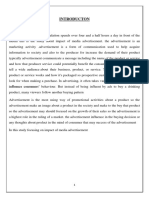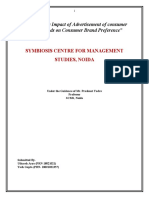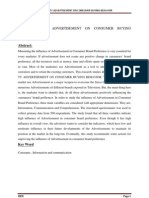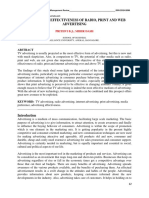0% found this document useful (0 votes)
65 views23 pagesAMR Assignment
This document discusses the impact of television advertisements on consumer buying behavior in India. It begins with an abstract that summarizes the study, which found that TV ads significantly influence Indians' purchasing process, with rural respondents showing more influence than urbanites. It then provides background on advertising and TV viewership in India. The literature review discusses how TV ads impact children, teenagers, and adults. Children and teens are heavily targeted due to their spending influence. Adults, especially women, spend many hours watching TV and passively absorb ads, which influence their product decisions.
Uploaded by
Pokemon FanCopyright
© © All Rights Reserved
We take content rights seriously. If you suspect this is your content, claim it here.
Available Formats
Download as DOCX, PDF, TXT or read online on Scribd
0% found this document useful (0 votes)
65 views23 pagesAMR Assignment
This document discusses the impact of television advertisements on consumer buying behavior in India. It begins with an abstract that summarizes the study, which found that TV ads significantly influence Indians' purchasing process, with rural respondents showing more influence than urbanites. It then provides background on advertising and TV viewership in India. The literature review discusses how TV ads impact children, teenagers, and adults. Children and teens are heavily targeted due to their spending influence. Adults, especially women, spend many hours watching TV and passively absorb ads, which influence their product decisions.
Uploaded by
Pokemon FanCopyright
© © All Rights Reserved
We take content rights seriously. If you suspect this is your content, claim it here.
Available Formats
Download as DOCX, PDF, TXT or read online on Scribd
/ 23






















































































